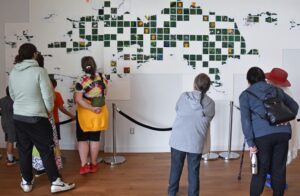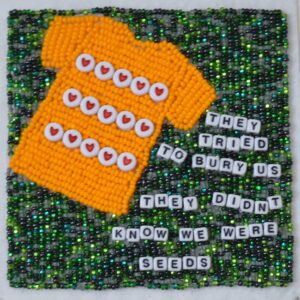Thousands of years of collective memories honoured in The Lake Nipissing Beading Project

By Kelly Anne Smith
NORTH BAY — About 100 guests and participants from Nipissing First Nation, Dokis First Nation, Kitigan Zibi Anishinabeg First Nation, and others of Turtle Island had an intimate viewing of the installation, The Lake Nipissing Beading Project, at the Nipissing University Student Union Student Centre on Aug. 26.
444 individually beaded squares make up the 5-metre map of Lake Nipissing and its waterways and tributaries.
The project honours the lake and is dedicated to Muriel Sawyer-Baa, late Nipissing First Nation Deputy Chief, language keeper, and education advocate.
Studying the installation, Glenna Beaucage said she had called up Elder June Commanda for the translation of bead, which is mnidoomnesag in Anishinaabemowin. It translates to good spirit.

“All those tiles represent our lives there. They have sturgeon fish and shadflies, turtles, Residential School. It’s all on there. People have beaded those. It’s an exhibit of many stories,” expressed Beaucauge. “When we were isolated doing this, it was different and now we see the life of it. To see the excitement and the beauty of it. There are thousands of years of memories in those tiles.”
Beading artist Carrie Allison, Nêhiyaw/Cree, Métis Treaty 8, and Dr. Kirsten Greer, Canada Research Chair in Global Environmental Histories and Geographies at Nipissing University, led the project in partnership with Dokis First Nation and Nipissing First Nation.
Dr. Greer says the project started right at the beginning of the COVID-19 pandemic as a project to engage with community members when they were in lock-down or in isolation. The first installation was at the Nova Scotia College of Art and Design Treaty Space Gallery in Halifax.
“It is really nice to see it come home and to meet all the people that have beaded. Just to see where they beaded and what they beaded and how that means something to them. And to see people happy. The feedback that we’ve had about this project has been really rewarding.”
After viewing the Lake Nipissing Beading Project, Nipissing and Dokis First Nation community members attended the North Bay Museum to view the exhibit, Our Guides are Really Going Places/Nishnaabeg e-paamwingewaad waasa zhaawag: Nbisiiing Guides, and the Legacy of Paul Commanda.
Nipissing First Nation Councillor Joan McLeod Shabogesic explains, “people are going to get more interested in our history now.”
“These two exhibits are very closely related. There’s Paul Commanda, the guide on the Carnegie exhibits, well, his daughter Josephine Beaucage, she was an influencer. She was a person that revitalized our beadworking at Nipissing and 33 other nations. Without her, I believe that our beading would have been lost. We wouldn’t have such an abundance of it today. When I looked at this project and saw the people getting involved, the younger generations, I realized there are five generations now since Josephine taught some of the ladies from our community,” McLeod Shabogesic explains. “Paul Commanda’s family is here today. One of the things our nation is going to learn is how closely related we all are, with families and other First Nations, too.”
In front of the beaded Lake Nipissing, Joan was observed pointing to a beaded tile, showing it to Nipissing First Nation Chief Scott McLeod Shabogesic.
“I did three tiles. One was the Beaucage tile and that tied in our Residential School at Beaucage Point. I also tied it into Semo Commanda, who’s the father of Paul and where he lived. I have a duck there because in some of the signings, people described him as the duck. I figure that might be his dodem. I also put on there the orange shirt with the 127 survivors we have that attended Residential School.”
Carrie Allison contributed a large beaded goose to the Carnegie Exhibit and a tile to the beaded Lake Nipissing.
“This project is sister to the project, The Shubenacadie River Beading Project, the first iteration of a collaborative community project beading water spaces. As you well know, water is life. This was a way to honour through collective hands.”
History professor Katrina Srigley says the spirit and intent of the work she’s been doing with Glenna Beaucage and the Elders and Knowledge Keepers of the Nbisiing Anishnaabe Nation has always been to centre and share the stories of the waters, land, of the people and the Lake Nipissing Beading Project is a meaningful way to establish and deepen those relationships.
“You’ll see on many of the squares, that these little spirits are connecting us to the ancestors, to the waters and to one another and they are also telling stories.”
Beginning Sept. 9, The Lake Nipissing Beading Project is open to the public at the NUSU Student Centre until Oct. 28. Afterwards it travels with The Guides are Really Going Places exhibit to the Sault Ste. Marie Museum, Thunder Bay Museum, Dokis Museum, and Timmins Museum.
Suzanne Campeau Whiteduck from Nipissing First Nation organized the Speakers Series part of the project. She explained gifts distributed to those who participated in the project: a cup featuring a tile beaded by Carrie Allison; a can of water from FN Clean Water supporting Water First, an organization that holds training sessions for Indigenous youth and young adults to ensure their communities have safe, clean water; animal stickers designed by North Bay artist Kristen Lovell; and tobacco ties as an added gift to say miigwech.


